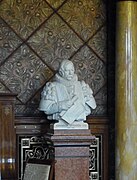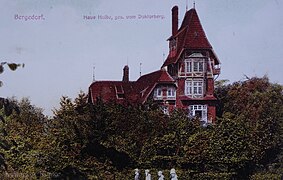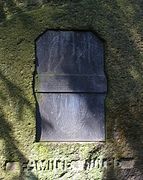Georg Hulbe
Georg Hulbe (born September 27, 1851 in Kiel , † November 16, 1917 in Hamburg ; full name: Georg Ernst Friedrich Hulbe ) was a German bookbinder and leather artisan at the time of historicism and art nouveau in Hamburg.
life and work
After moving to Hamburg, Hulbe had his first workshop, first in Barmbek, then on Alstertwiete. From 1884 to 1889 at Lindenstrasse 13 in the St. Georg district. In 1885 a workshop was added at Bergstrasse 23 and at (Altonaer) Bachstrasse 63 (today Pepermölenbek). After completing the major orders for the Berlin Reichstag and Hamburg City Hall, he relocated these workshops to his own property in Lindenstrasse 43/47 in 1889. From 1894 to 1911 there was also a shop at Jungfernstieg 26 ( Hamburger Hof ) before the company's own building at Mönckebergstrasse 21, the Hulbe House , was completed. From 1887 to 1911 there was a branch or sales point in Leipziger Strasse 121 in Berlin . The branch in Frankfurt am Main at that time was also in an exclusive location ( Goethestrasse 19).
He had the Hulbe House in the 1908 newly laid out Mönckebergstrasse in Hamburg's city center built in 1910 as his own new “arts and crafts house” directly below the Petrikirche in 1910 by the architect Henry Grell (1870–1937). It not only served as a sales outlet for its own and other handicraft products, but also as a space for art exhibitions. The house with its special facade design and roof landscape was crowned by a gilded cog , the signet Hulbes, which can also be found as a master stamp on many of his works. Hulbe was a member of the Hamburg Artists' Association from 1832 .
Hulbe manufactured high-quality and high-priced leather works, writing cases, screens , caskets, furniture, wallpaper and more. A special feature was the high-quality hallmarking and embossing, also known as embossing on leather . Among other things, he made the leather furnishings for the Hamburg City Hall and the Reichstag in Berlin.
For the inauguration of the Hamburg City Hall in 1897, he made the city's golden book . The leather cut work shows the Hamburg state coat of arms on the front cover, underneath the motto “God with us”. The corners consist of hand-driven and gold-plated silver fittings , the back cover bears the German imperial eagle .
The Golden Book of the City of Poznan, which he made, is decorated with hand sculptures , the corners are also handcrafted from silver. The entire cover has been gilded, and the red leather shines through in the raised areas to give the impression of age and worn out from the start.
He made a genealogical table in leather for the home Bismarck to -Schönhausen. The autotypical replica from 1904 shows a branch of the family in leather cut work. The metals were treated in gold and silver, the coats of arms painted, the individual members of the house represented in coats of arms connected by oak branches .
Hulbe 1899 was judge of a competition for the design of Stollwerck - scrapbook for Stollwerck collecting images along with the collector Justus Brinckmann, the architect Wilhelm Emil Meerwein and the painter Julius Christian Rehder from Hamburg and the architect Bruno Schmitz from Berlin. Numerous articles in the trade press of the time document Georg Hulbe's high reputation as a craftsman.
Hulbe lived in Bergedorf since 1892 , initially at Jacobstrasse 4a (today Duwockskamp). Then in 1896, at the end of Reinbeker Weg, on the edge of an extensive wooded garden in what would later become Hochallee 3 (today Pfingstberg), he had the "Villa Waldheim" built. The architect was Johann Gottlieb Rambatz (1859–1920), the house was demolished in 1959. The exceptionally large garden was parceled out and is now built with single-family houses with the street name Hulbepark .
Georg Hulbe was married twice. After the death of his first wife Dorothea Maria Caroline geb. Jipp (1850–1905) he married Martha Marie Anna geb. Schulze (1864–1926), an employee of his company. Hulbe died two years after his friend Justus Brinckmann in 1917 at the age of 66 and was buried in the Bergedorf cemetery. The grave with the large boulder has been preserved. The text "Wanderer's Night Song" by Goethe is written on the bronze plate, which is embedded in the boulder. Hulbe's heirs are called Schulze-Hulbe.
His business in the Hulbe house continued and was not sold by his heirs until the 1930s.
When the Hamburg City Hall was restored inside and out in connection with its centenary in the mid-1990s, the leather wallpapers and leather armchairs could be processed with Hulbe's original leather cutting and punching tools, because these are now owned by Germany's oldest leather punching workshop in Hamburg , the company Vanino & Henkel .
literature
- Anja Katthöfer: Georg Hulbe (1851–1917). A Hamburg artisan in the age of historicism. unpublished master's thesis, University of Kiel, 1997.
- Olaf Matthes, Bardo Metzger (ed.): Bergedorfer Personenlexikon. Hamburg 2003, p. 97 ff.
- Harald Richert: Old families in Bergedorf - Georg Hulbe. In: Lichtwark No. 46, p. 6. Ed. Lichtwark Committee, Bergedorf, 1982. See now: Verlag HB-Werbung, Hamburg-Bergedorf. ISSN 1862-3549 .
- Harald Richert: Between Bille and Elbe. District lexicon of the Bergedorf district. Hamburg 1987.
- Alfred Rohde: Hulbe, Georg . In: Hans Vollmer (Hrsg.): General lexicon of fine artists from antiquity to the present . Founded by Ulrich Thieme and Felix Becker . tape 18 : Hubatsch – Ingouf . EA Seemann, Leipzig 1925, p. 105 .
Web links
- Literature by and about Georg Hulbe in the catalog of the German National Library
- Texts and photos (and advertisements) in numerous contemporary specialist journals (digitized by Heidelberg University) digi.ub.uni-heidelberg.de
Individual evidence
- ↑ Kunstgewerbeblatt, New Series. 10th year 1899, No. #, S. #.
- ^ Photo from 1958 in: Olaf Matthes: Hamburg-Bergedorf in the photographs of Egon Klebe. Sutton, Erfurt 2010, ISBN 978-3-86680-726-6 , p. 28.
- ↑ Goethe: Wanderer's Night Song (1780): “Above all the peaks there is peace, in all the treetops you hardly feel a breath; the birds are silent in the forest, just wait, soon you will rest too. "
- ↑ Mario Marquardt - Lederkunsthandwerk since 1931 vanino-und-henkel.de
| personal data | |
|---|---|
| SURNAME | Hulbe, Georg |
| ALTERNATIVE NAMES | Hulbe, Georg Ernst Friedrich |
| BRIEF DESCRIPTION | German bookbinder and leather artisan |
| DATE OF BIRTH | September 27, 1851 |
| PLACE OF BIRTH | Kiel |
| DATE OF DEATH | November 16, 1917 |
| Place of death | Hamburg |



















